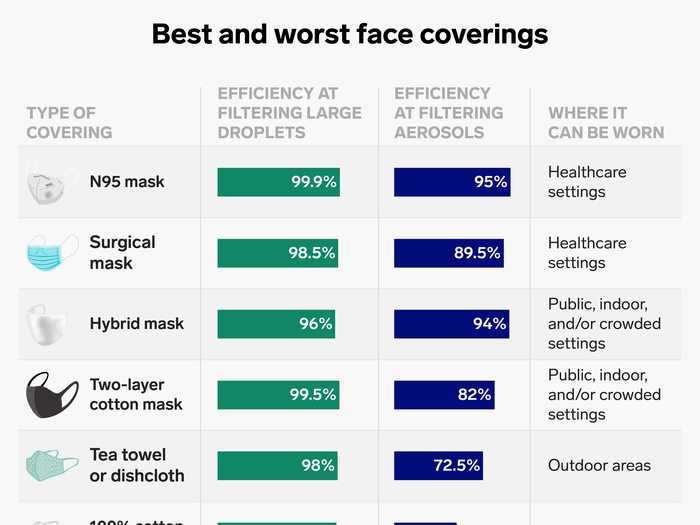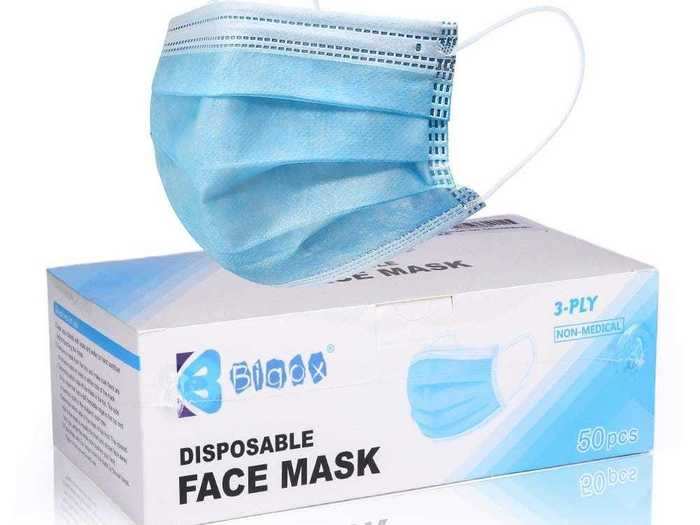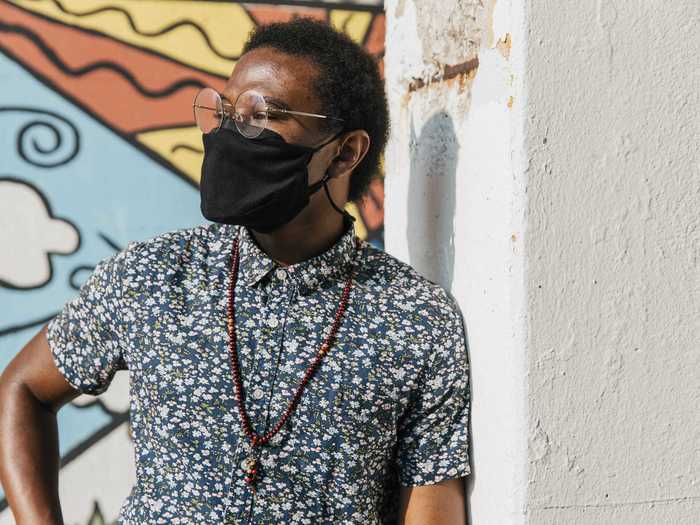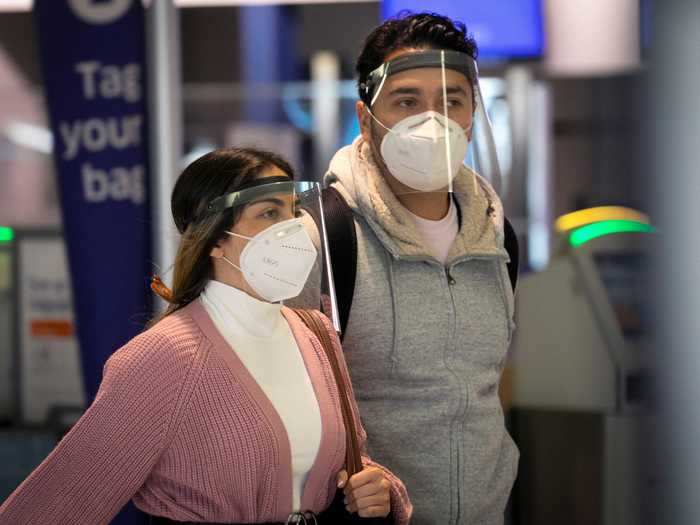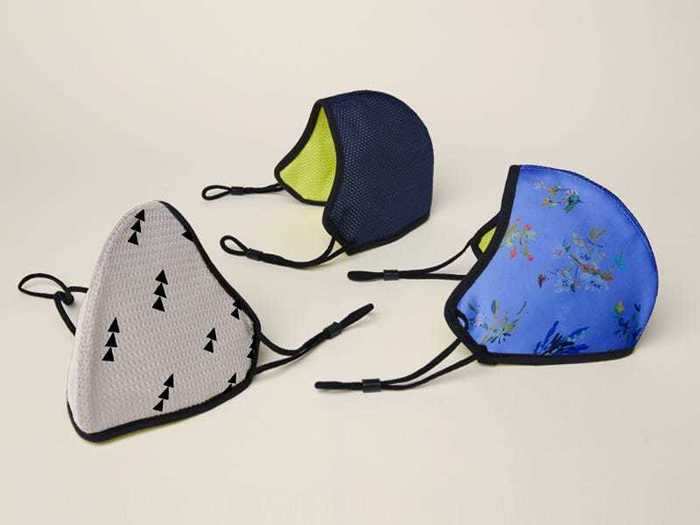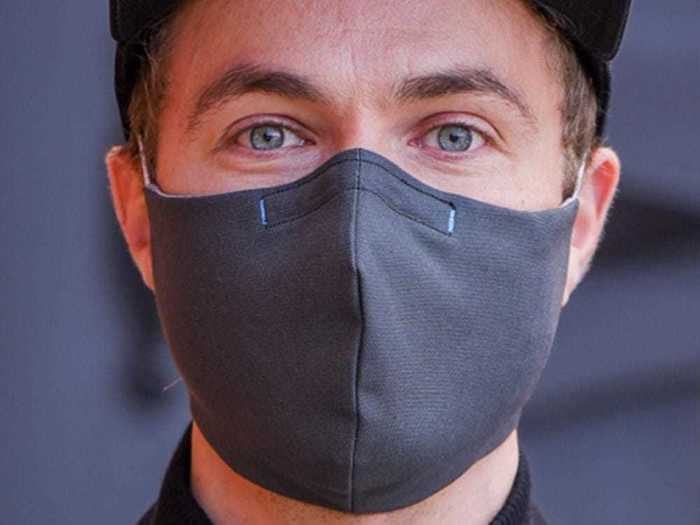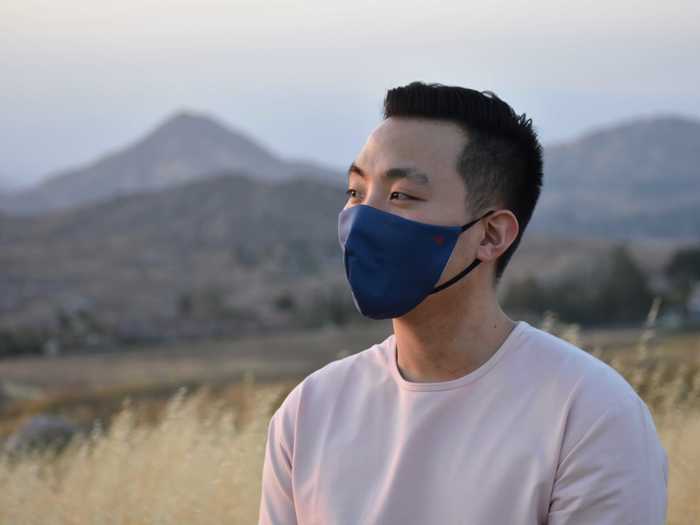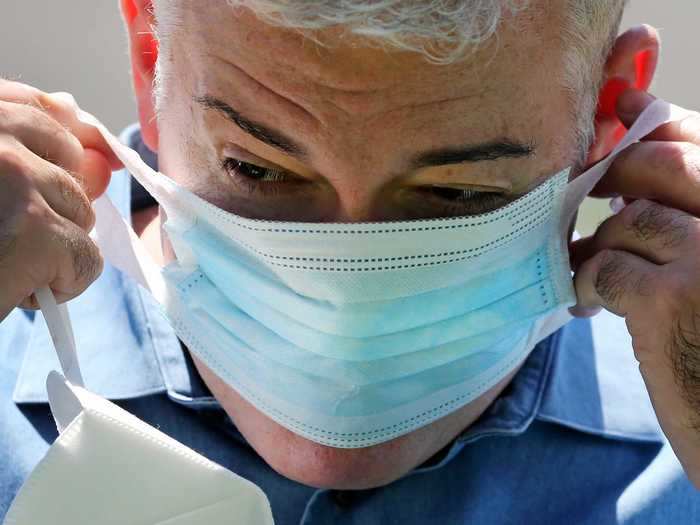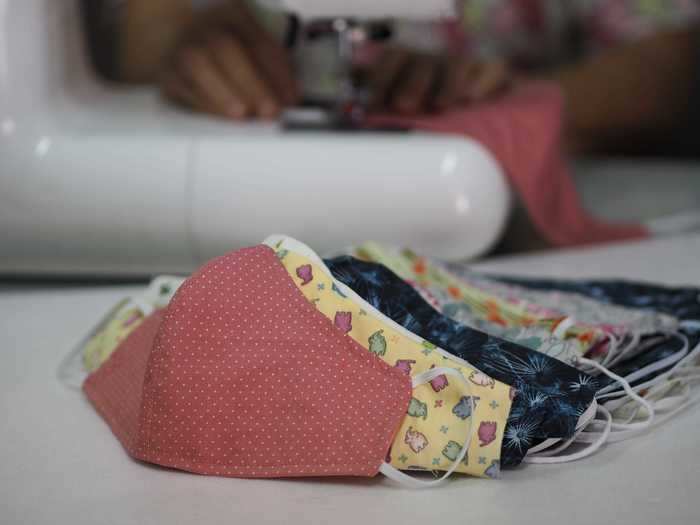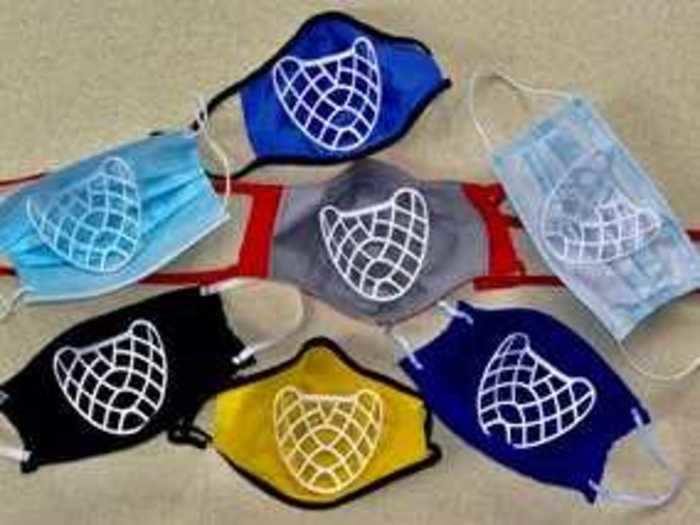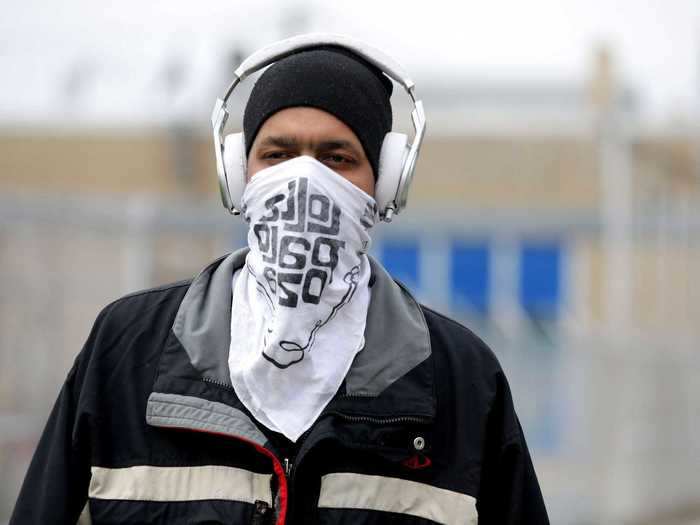Tom Bihn's multi-layered face mask.TOM BIHN
- Medical experts understand the challenge of finding a face mask that's both comfortable and protective.
- Four doctors and one mask researcher told Business Insider the masks they recommend for situations outside of hospitals and clinics.
- Some recommended DIY options, while others suggested multi-layer masks that have undergone independent filtration tests.
To pick the right face mask, doctors often recommend a simple trick: Try blowing out a candle while wearing it. A good mask should prevent you from extinguishing the flame.
But it can be difficult to know whether a mask will pass the candle test just by looking at it.
So Business Insider asked four doctors and one mask researcher about the face coverings they wear outside work and those that meet their safety criteria. Some recommended DIY options, while others suggested multi-layer masks that have undergone independent filtration tests.
All experts agreed that it's better to choose a mask you won't be itching to take off.
"The best mask is the one that fits and that you're actually wearing," Dr. Alice Sato, an epidemiologist at Children's Hospital & Medical Center in Omaha, Nebraska, told Business Insider.
Here are their recommendations, plus a few tips for making masks more comfortable.
The Centers for Disease Control and Prevention recommends multi-layer cloth masks for the general public.
Yuqing Liu/Business Insider
The ideal mask blocks both large respiratory droplets from coughs or sneezes, along with smaller airborne particles called aerosols, which are produced when people talk or exhale.
It should be sealed around the nose and mouth, since any gaps, holes, or vents could allow droplets to leak out and infect others. Sato said plenty of non-medical masks meet that criteria.
"We've actually not seen a very large difference at all between well-fitted ear loop masks or surgical masks compared to N95 respirators for this disease [COVID-19]," she said. "Really that fit is almost more important than that slight difference in the filtration."
Dr. Ricardo Correa, an endocrinologist at the University of Arizona College of Medicine, said a simple surgical mask is a good low-cost option.
Amazon/Bigox
During procedures, Correa said, he wears an N95 mask, which contains tangled fibers to filter airborne pathogens (the name refers to their minimum 95% efficiency at filtering aerosols).
But outside the office or clinic, Correa often wears a standard surgical mask from the Amazon vendor Bigox.
"The ones that I bought on Amazon were as good as the ones in the hospital," he told Business Insider.
The masks pass the candle test, he added, and they're inexpensive.
Surgical masks are made of non-woven fabric, so they're usually the safest option for healthcare workers who don't have access to an N95. A 2013 study found that surgical masks are about three times as effective at blocking virus-containing aerosols than homemade face masks. (That was true, at least, when air flow was slower than a cough but faster than a human breathing during light work.)
A recent study from the National Institute for Occupational Safety and Health (NIOSH) found that a medical-grade procedure mask blocked 59% of respiratory aerosols from a cough, whereas a three-layer cotton mask blocked 51% of these aerosols.
Correa also suggested cloth masks from Tom Bihn, which are multi-layered and adjustable to prevent slipping.
TOM BIHN
At $9 to $16 per mask, the face covering is "a little bit more expensive," Correa said, "but you can use it multiple times."
At the beginning of the pandemic, he added, US residents were advised to make their own face coverings. Correa said not to do that anymore, since it's hard to know if your fabric is woven tightly enough.
Tom Bihn's original masks are made of two layers of a polyester-cotton blend. Other versions include two layers of 100% cotton twill (diagonally woven fibers) and two layers of 100% cotton flannel. There's also a three-layer mask with two layers of cotton twill and an outermost layer of polyester-cotton.
An April study from the University of Chicago determined that "hybrid" masks — which combine two layers of 600-thread-count cotton with another material like silk, chiffon, or flannel — filtered at least 94% of small particles (less than 300 nanometers) and at least 96% of larger particles.
Two layers of 600-thread-count cotton offered a similar level of protection against larger particles, but they weren't as effective at filtering aerosols. That study, however, conducted measurements at low air-flow rates, so the masks might offer less protection against a cough or a sneeze.
If traveling, Correa said, it's a good idea to combine a face mask and face shield.
A couple wear protective face shields and masks at Newark International Airport on November 25, 2020.
Mike Segar/Reuters
Correa expects masks to be necessary for a while.
"Even now that we have the vaccine, it will take probably the first six months of 2021 to vaccinate a big bunch of the population, so we still will need to continue using masks," he said.
Face shields aren't very protective on their own: The NIOSH study found they only blocked 2% of respiratory aerosols from a cough. But they can provide an added layer of protection when worn with a mask.
Since they're plastic, Correa said, "any brand will work."
Dr. Megan Ranney, director of the Brown University Lifespan Center for Digital Health, said masks with a wire along the nose - like these Happy Masks - keep glasses from fogging.
Happy Masks
Ranney shared her recommendation on Twitter. Another DIY option for glasses-wearers, she added, is using double-sided tape on the nose bridge.
Happy Masks are made of five layers: a quick-dry inner and outer layer, plus three built-in filters that are meant to last for at least 50 washes. The middle layer filtered more than 99% of tiny particles (0.3 microns) in independent lab tests.
"As a pediatrician, these are the most comfortable cloth masks on the market," Kristina Phillips Wenger, who practices in Paragould, Arkansas, wrote on Facebook. "I've tried dozens of different masks thus far. It's clear that these are quality masks designed to protect as close to medical masks as possible."
For maximum protection, Dr. Monica Gandhi and aerosol expert Linsey Marr both suggest a three-layer mask, like this one from Kitsbow.
KITSBOW
Gandhi is a professor of medicine at the University of California, San Francisco, and Marr is an environmental engineer at Virginia Tech. They tested 10 different face coverings for an upcoming paper. The most protective, they found, had outer layers of a flexible, tightly-woven fabric and a middle layer with a non-woven filter.
In a November study that's still awaiting peer review, Marr found that these masks were more than 70% efficient at filtering tiny particles (around 2 micrometers). If the masks fit well, they could also be more than 90% efficient at filtering particles 1 micrometer and larger, the study found.
Marr said she has received mask samples from Kitsbow, a cycling apparel company that now manufactures personal protective equipment. They seemed to fit the bill.
The company's reusable face mask has a pocket to insert a filter (each mask comes with two filters). Another version has a filter sewn in. Kitsbow masks also come in different sizes so that users can get the tightest seal possible.
Oura's four-layer mask also fits the researchers' criteria.
OURA
Oura says its Air Mask filters more than 95% of viral particles in independent lab tests. The mask also has a water repellant outer layer, adjustable nose clip, and lightweight fabric. But it has a hefty price tag: $70.
For basic protection, Gandhi and Marr suggest a high-quality surgical mask or a mask with at least two layers of a high-thread-count fabric.
Another highly protective option is to layer a surgical mask with a cloth one.
Brendan Williams, president of the New Hampshire Health Care Association, puts on a surgical mask while carrying another mask.
Charles Krupa/AP Photo
In this case, Gandhi and Marr found, the surgical mask acts as a filter, while placing the cloth mask on the outside helps ensure a tight seal.
If you are opting for a homemade mask, Sato recommended one that sews at least two pieces of fabric together, with a paper towel in the middle.
Getty
Sato said she's fond of the cotton masks a friend made for her. She recommended adding a few pleats to ensure a good fit.
"If I go out to buy groceries and I'm wearing a two layer, well-fitting, cotton mask, I feel really good about that," she said.
Paper towels, she said, are an inexpensive, easy-to-replace substitute for a filter.
"The idea behind the middle layer is to have a more felt-like material that doesn't have a weave," Sato said. "I would not cut down a vacuum cleaner bag because the cut edges could have fibers that you don't want to inhale."
No matter what, she added, it's important not to compromise the fit.
"I can make a beautiful mask, but if it's not really sitting on my face, it's not helping me as much," she said.
Sato said some of her colleagues insert a plastic cup or bracket into their mask to give them more room to breathe.
HeartFormSF
The accessory is available in bulk on Amazon. It's particularly useful for essential workers who are required to wear masks all day.
"I can talk all day at school and be heard clearly," Angie Madden, a second grade teacher who lives in Milledgeville, Georgia, recently told Insider. "It was a win-win."
Any mask is generally better than none.
Kevin Houston uses a bandana to cover his face on April 23, 2020, in Evanston, Illinois.
Stacey Wescott/Chicago Tribune/Tribune News Service/Getty Images
Correa said people should refrain from wearing masks with one-way valves, which can expel infectious particles into the surrounding air. The CDC also cautions against those.
The other type to avoid, according to a study from Duke researchers, is polyester spandex neck fleeces. These might actually increase the rate of droplet transmission during speech.
However, Sato said that study didn't distinguish between droplets and infectious particles.
"It only looked at the visualization of particles coming out in front of the mask, so that doesn't tell you about whether that's protecting from infection or not," she said.
Multiple studies have shown that bandanas and scarves are less protective than other face coverings, though.
"We definitely know that if you wear an old-style cowboy bandana with a bottom flap just as a triangle, that's not fitted to under your chin," Sato said. "So you can show that when people cough, it tends to flap up in the wind and it does not keep things from spreading as far."
But even those face coverings are better than none, she added.
"It's not feasible for some people to spend $20 per mask," Sato said. "If they already own a gaiter and that's what they're going to use, it doesn't make sense to me that it would be worse than not wearing anything."

